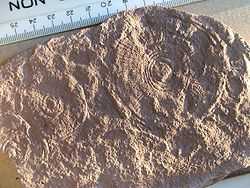Cyclomedusa
| Cyclomedusa Temporal range: Mayanian–Ediacaran | |
|---|---|
 | |
| Three specimens of Cyclomedusa. Metric scale. | |
| Scientific classification | |
| Domain: | Eukaryotes |
| Kingdom: | Animalia |
| Genus: | Cyclomedusa |
| Species: | C. davidii |
Cyclomedusa is a circular fossil of the Ediacaran biota; it has a circular bump in the middle and as many as five circular growth ridges around it. Many specimens are small, but specimens in excess of 20 cm are known. The concentric disks are not necessarily circular, especially when adjacent individuals interfere with each other's growth. Many radial segment lines — somewhat pineapple-like — extend across the outer disks. A few specimens show what might be a stem extending from the center in some direction or other.
Cyclomedusa is widely distributed in Ediacaran strata, with a number of species described. It has also been found in sediments dating to the Mayanian (~1,000 million years ago).[1] Cyclomedusa was originally thought to be a jellyfish[2] but some specimens seem to be distorted to accommodate adjacent specimens on the substrate, apparently indicating a benthic (bottom-dwelling) creature.[3] The markings do not match the musculature pattern of modern jellyfish. The fossils have been conjectured to represent a holdfast for some stalked form — possibly an octacorallian, or something else entirely.[4] Alternatively, it was thought that the described species actually represent different modes of preservation for one organism or that several different organisms have been grouped together under one name as a form taxon.
It is now suggested that Cyclomedusa was a microbial colony;[5] D. Grazhdankin reinterprets the concentric rings and radial structures as comparable to those seen in modern-day microbial colonies exposed to homogeneously distributed environmental conditions.
Cyclomedusa is known from Neoproterozoic beds in Ediacara (Australia), Finnmark (Norway), Charnwood Forest (England), Olenek (Russia), North China, Newfoundland, Northwest Canada, Podolia (Ukraine), the Ural Mountains (Russia), the White Sea (Russia), and Sonora (Mexico). It is regarded as a member of the Ediacaran biota— a group of somewhat obscure organisms that thrived just before most of the modern multicellular animal phyla appeared. Cyclomedusa has no known relatives.[6]
See also
References
- ↑ Khomentovsky, V.; Nagovitsin, K.; Postnikov, A. (2008). "Mayanian (1100–850 Ma) – Prebaikalian Upper Riphean of Siberia". Russian Geology and Geophysics 49: 1–6. Bibcode:2008RuGG...49....1K. doi:10.1016/j.rgg.2007.12.001.
- ↑
- Sprigg, R. C. (1947): "Early Cambrian jellyfishes (?) from the Flinders Range, South Australia", Transactions of the Royal Society of South Australia. 71.2, p. 220
- ↑ (University of California at Berkeley) Cyclomedusa
- ↑ (Queens University) "Disk-Form Fossils of Canada". Adolf Seilacher, in a series of papers (1985-92) called into question the assignment of the Ediacaran organisms to Animalia.
- ↑ GRAZHDANKIN, D.; GERDES, G. (2007). "Ediacaran microbial colonies". Lethaia 40 (3): 201–210. doi:10.1111/j.1502-3931.2007.00025.x.
- ↑ The few Ediacaran biota that survived into the Cambrian are discussed by Conway Morris 1993 and Narbonne 1998. However, if Cyclomedusa was a microbial colony, related microbes may be extant.